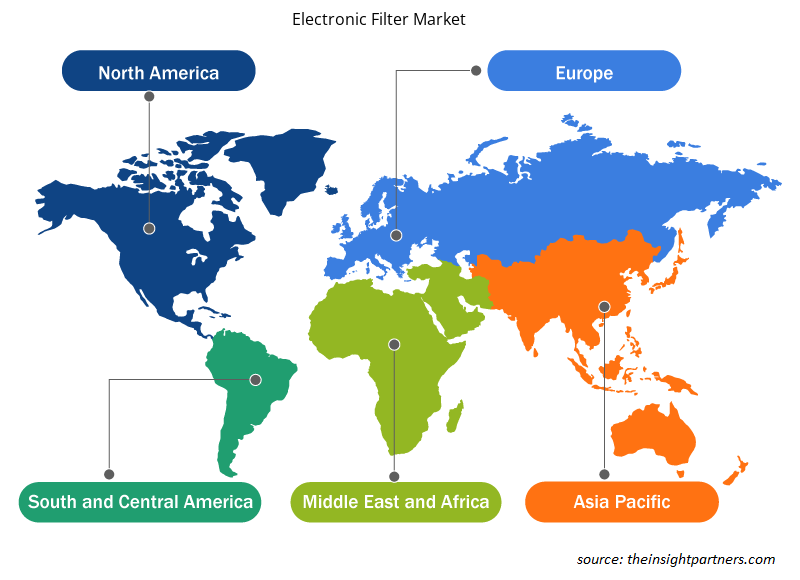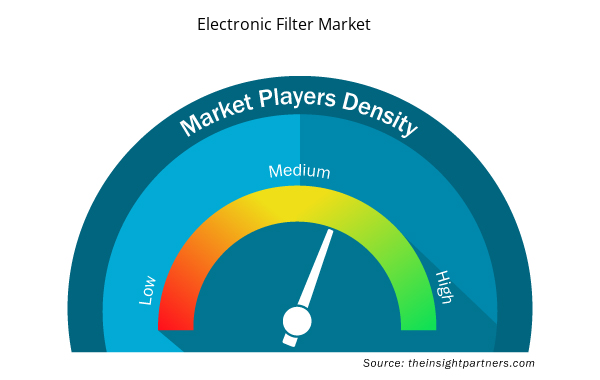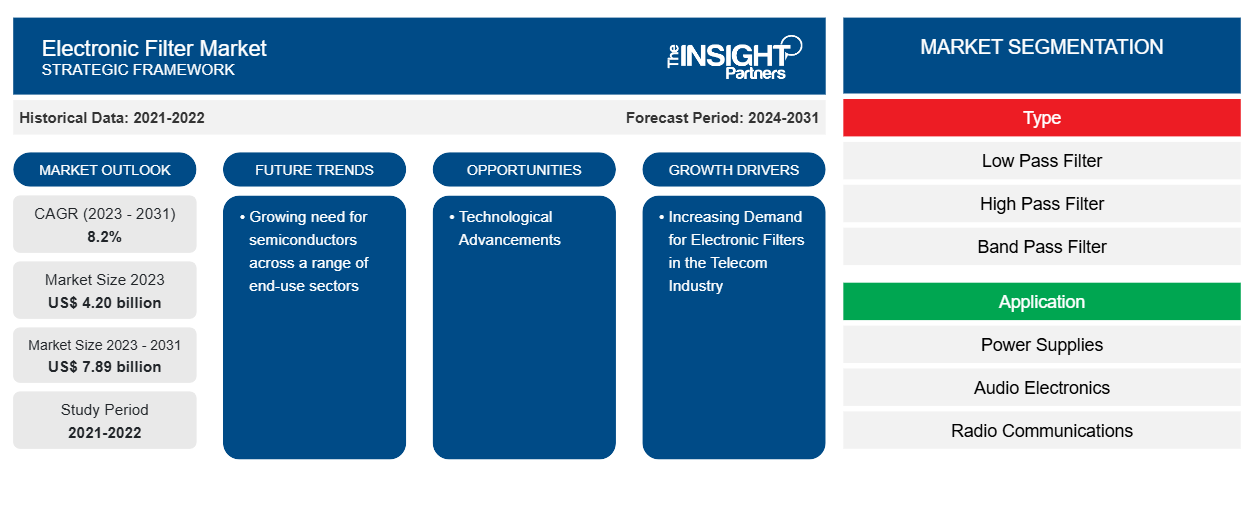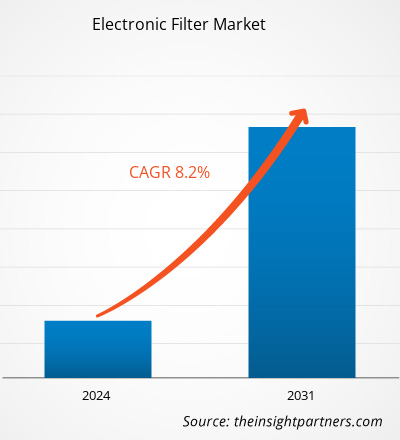Der globale Markt für elektronische Filter wird voraussichtlich von 4,20 Milliarden US-Dollar im Jahr 2023 auf 7,89 Milliarden US-Dollar im Jahr 2031 wachsen; von 2023 bis 2031 wird eine durchschnittliche jährliche Wachstumsrate von 8,2 % erwartet. Der wachsende Bedarf an Halbleitern in einer Reihe von Endverbrauchssektoren wird voraussichtlich weiterhin ein wichtiger Trend auf dem Markt für elektronische Filter bleiben.
Elektronische Filter Marktanalyse
Der Markt für elektronische Filter wird vor allem durch die steigende Nachfrage nach elektronischen Filtern in der Telekommunikationsbranche angetrieben. Darüber hinaus sind die Einführung von 5G und die zunehmende Nutzung von LTE-Netzen, insbesondere in Schwellenländern, die Haupttreiber für die Expansion des globalen Telekommunikationssektors und tragen auch zum Wachstum des Marktes für elektronische Filter bei.
Marktübersicht für elektronische Filter
Ein elektronischer Filter ist eine Schaltung oder ein Gerät, das dazu dient, bestimmte Frequenzen in einem elektrischen Signal zu ändern, umzuformen oder abzulehnen, während gewünschte Frequenzen durchgelassen werden. Filter werden in vielen Branchen eingesetzt, darunter Stromversorgung, Audioelektronik, Funkkommunikation sowie Signal- und Bildverarbeitungssysteme. Es gibt verschiedene Filtertypen, darunter Tiefpass-, Hochpass-, Bandpass- und Sperrfilter. Filter werden in verschiedenen Bereichen eingesetzt, darunter Stromversorgung, Audioelektronik, Funkkommunikation sowie Signal- und Bildverarbeitungssysteme. Sie können je nach den in ihrer Konstruktion verwendeten Komponenten als passiv oder aktiv klassifiziert werden.
Passen Sie diesen Bericht Ihren Anforderungen an
Sie erhalten kostenlos individuelle Anpassungen an jedem Bericht, einschließlich Teilen dieses Berichts oder einer Analyse auf Länderebene, eines Excel-Datenpakets sowie tolle Angebote und Rabatte für Start-ups und Universitäten.
- Holen Sie sich die wichtigsten Markttrends aus diesem Bericht.Dieses KOSTENLOSE Beispiel umfasst eine Datenanalyse von Markttrends bis hin zu Schätzungen und Prognosen.
Treiber und Chancen auf dem Markt für elektronische Filter
Steigende Nachfrage nach elektronischen Filtern in der Telekommunikationsbranche begünstigt den Markt
Der Telekommunikationssektor verändert sich allmählich aufgrund des sich ständig ändernden technologischen Umfelds und der zunehmenden Nutzung von Smartphones und anderen vernetzten Geräten auf der ganzen Welt. Darüber hinaus sind die Einführung von 5G und die zunehmende Nutzung von LTE-Netzen, insbesondere in Schwellenländern, die Haupttreiber der Expansion des globalen Telekommunikationssektors. Der Bedarf an elektronischen Filtern im weltweiten Telekommunikationssektor wird durch die starke Wachstumsprognose der Branche getrieben, die sich aus der zunehmenden Netzdurchdringung und der Kundennachfrage nach digitalen Inhalten ergibt.
Technologische Fortschritte
Heutzutage werden elektronische Filter mit anderen Spitzentechnologien wie Robotik, maschinellem Lernen und künstlicher Intelligenz (KI) kombiniert. Diese Verbindung ermöglicht eine verbesserte Automatisierung und erweiterte Funktionalität in einer Reihe von Anwendungen. Filter, die auf künstlicher Intelligenz basieren, sind beispielsweise in der Lage, komplexe Datenmuster zu analysieren und in Echtzeit anzupassen, um die Effizienz zu maximieren.
Segmentierungsanalyse des Marktberichts für elektronische Filter
Schlüsselsegmente, die zur Ableitung des Typs und der Anwendung der Marktanalyse für elektronische Filter beigetragen haben.
- Nach Typ ist der Markt in Tiefpassfilter, Hochpassfilter, Bandpassfilter, Bandsperrfilter und Allpassfilter unterteilt. Das Segment der Tiefpassfilter hatte im Jahr 2023 einen größeren Marktanteil.
- Basierend auf der Anwendung ist der Markt in Stromversorgung, Audioelektronik , Funkkommunikation und Analog-Digital-Umwandlung unterteilt. Das Segment Audioelektronik hatte im Jahr 2023 einen größeren Marktanteil.
Marktanteilsanalyse für elektronische Filter nach Geografie
Der geografische Umfang des Marktberichts für elektronische Filter ist hauptsächlich in fünf Regionen unterteilt: Nordamerika, Asien-Pazifik, Europa, Naher Osten und Afrika sowie Südamerika/Süd- und Mittelamerika. Nordamerika dominierte den Markt für elektronische Filter im Jahr 2023. Einer der Hauptfaktoren, die den Markt für elektronische Filter antreiben, ist die optimistische Entwicklungsprognose des Telekommunikationssektors in Nordamerika. Der Markt wächst aufgrund des steigenden Bedarfs der Telekommunikationsbranche an elektronischen Filtern.
Regionale Einblicke in den Markt für elektronische Filter
Die regionalen Trends und Faktoren, die den Markt für elektronische Filter im gesamten Prognosezeitraum beeinflussen, wurden von den Analysten von Insight Partners ausführlich erläutert. In diesem Abschnitt werden auch die Marktsegmente und die Geografie für elektronische Filter in Nordamerika, Europa, im asiatisch-pazifischen Raum, im Nahen Osten und Afrika sowie in Süd- und Mittelamerika erörtert.

- Erhalten Sie regionale Daten zum Markt für elektronische Filter
Umfang des Marktberichts für elektronische Filter
| Berichtsattribut | Details |
|---|---|
| Marktgröße im Jahr 2023 | 4,20 Milliarden US-Dollar |
| Marktgröße bis 2031 | 7,89 Milliarden US-Dollar |
| Globale CAGR (2023 - 2031) | 8,2 % |
| Historische Daten | 2021-2022 |
| Prognosezeitraum | 2024–2031 |
| Abgedeckte Segmente | Nach Typ
|
| Abgedeckte Regionen und Länder | Nordamerika
|
| Marktführer und wichtige Unternehmensprofile |
|
Dichte der Marktteilnehmer für elektronische Filter: Deren Auswirkungen auf die Geschäftsdynamik verstehen
Der Markt für elektronische Filter wächst rasant, angetrieben durch die steigende Nachfrage der Endnutzer aufgrund von Faktoren wie sich entwickelnden Verbraucherpräferenzen, technologischen Fortschritten und einem größeren Bewusstsein für die Vorteile des Produkts. Mit steigender Nachfrage erweitern Unternehmen ihr Angebot, entwickeln Innovationen, um die Bedürfnisse der Verbraucher zu erfüllen, und nutzen neue Trends, was das Marktwachstum weiter ankurbelt.
Die Marktteilnehmerdichte bezieht sich auf die Verteilung der Firmen oder Unternehmen, die in einem bestimmten Markt oder einer bestimmten Branche tätig sind. Sie gibt an, wie viele Wettbewerber (Marktteilnehmer) in einem bestimmten Marktraum im Verhältnis zu seiner Größe oder seinem gesamten Marktwert präsent sind.
Die wichtigsten auf dem Markt für elektronische Filter tätigen Unternehmen sind:
- ABB Ltd.
- AVX Corporation
- BLOCK Transformatoren-Elektronik GmbH
- Captor Corporation
- Anritsu
- CD Automation UK Ltd.
Haftungsausschluss : Die oben aufgeführten Unternehmen sind nicht in einer bestimmten Reihenfolge aufgeführt.

- Überblick über die wichtigsten Akteure auf dem Markt für elektronische Filter
Neuigkeiten und aktuelle Entwicklungen zum Markt für elektronische Filter
Der Markt für elektronische Filter wird durch die Erhebung qualitativer und quantitativer Daten nach Primär- und Sekundärforschung bewertet, die wichtige Unternehmensveröffentlichungen, Verbandsdaten und Datenbanken umfasst. Im Folgenden finden Sie eine Liste der Entwicklungen auf dem Markt:
- Im Februar 2024 bringt ABB India seinen Kompaktantrieb der nächsten Generation, ACH180, für HVACR-Geräte (Heizung, Lüftung, Klimaanlage und Kühlung) auf den Markt. Als neueste Ergänzung des HVACR-Antriebsportfolios von ABB ermöglicht der ACH180 die professionelle Steuerung hocheffizienter Motoren und nutzt gleichzeitig ein kompaktes Design für Platzersparnis, geringere Investitionskosten und einfachere Inbetriebnahme. Mit einem eingebauten Filter zur Reduzierung hochfrequenter Emissionen kann der Antrieb in industriellen oder häuslichen Umgebungen eingesetzt werden, ohne dass zusätzliche externe Filter gekauft und installiert werden müssen.
(Quelle: ABB, Pressemitteilung, 2024)
Marktbericht zu elektronischen Filtern – Umfang und Ergebnisse
Der Bericht „Marktgröße und Prognose für elektronische Filter (2021–2031)“ bietet eine detaillierte Analyse des Marktes, die die folgenden Bereiche abdeckt:
- Marktgröße und Prognose auf globaler, regionaler und Länderebene für alle wichtigen Marktsegmente, die im Rahmen des Projekts abgedeckt sind
- Marktdynamik wie Treiber, Beschränkungen und wichtige Chancen
- Wichtige Zukunftstrends
- Detaillierte PEST/Porters Five Forces- und SWOT-Analyse
- Globale und regionale Marktanalyse mit wichtigen Markttrends, wichtigen Akteuren, Vorschriften und aktuellen Marktentwicklungen
- Branchenlandschaft und Wettbewerbsanalyse, einschließlich Marktkonzentration, Heatmap-Analyse, prominenten Akteuren und aktuellen Entwicklungen
- Detaillierte Firmenprofile
- Historische Analyse (2 Jahre), Basisjahr, Prognose (7 Jahre) mit CAGR
- PEST- und SWOT-Analyse
- Marktgröße Wert/Volumen – Global, Regional, Land
- Branche und Wettbewerbsumfeld
- Excel-Datensatz



Report Coverage
Revenue forecast, Company Analysis, Industry landscape, Growth factors, and Trends

Segment Covered
This text is related
to segments covered.

Regional Scope
North America, Europe, Asia Pacific, Middle East & Africa, South & Central America

Country Scope
This text is related
to country scope.
Häufig gestellte Fragen
The electronic filter market size is expected to grow from US$ 4.20 billion in 2023 to US$ 7.89 billion by 2031; it is anticipated to expand at a CAGR of 8.2% from 2024 to 2031.
The market for electronic filters is mostly driven by increasing demand for electronic filters in the telecom industry.
The growing need for semiconductors across a range of end-use sectors is likely to remain key electronic filter market trends.
The key players holding the majority of shares in global electronic filters are ABB Ltd., AVX Corporation, BLOCK Transformatoren-Elektronik GmbH, Captor Corporation, and Anritsu.
The global electronic filter market is expected to reach US$ 7.89 billion by 2031.
Trends and growth analysis reports related to Electronics and Semiconductor : READ MORE..
The Insight Partners performs research in 4 major stages: Data Collection & Secondary Research, Primary Research, Data Analysis and Data Triangulation & Final Review.
- Data Collection and Secondary Research:
As a market research and consulting firm operating from a decade, we have published and advised several client across the globe. First step for any study will start with an assessment of currently available data and insights from existing reports. Further, historical and current market information is collected from Investor Presentations, Annual Reports, SEC Filings, etc., and other information related to company’s performance and market positioning are gathered from Paid Databases (Factiva, Hoovers, and Reuters) and various other publications available in public domain.
Several associations trade associates, technical forums, institutes, societies and organization are accessed to gain technical as well as market related insights through their publications such as research papers, blogs and press releases related to the studies are referred to get cues about the market. Further, white papers, journals, magazines, and other news articles published in last 3 years are scrutinized and analyzed to understand the current market trends.
- Primary Research:
The primarily interview analysis comprise of data obtained from industry participants interview and answers to survey questions gathered by in-house primary team.
For primary research, interviews are conducted with industry experts/CEOs/Marketing Managers/VPs/Subject Matter Experts from both demand and supply side to get a 360-degree view of the market. The primary team conducts several interviews based on the complexity of the markets to understand the various market trends and dynamics which makes research more credible and precise.
A typical research interview fulfils the following functions:
- Provides first-hand information on the market size, market trends, growth trends, competitive landscape, and outlook
- Validates and strengthens in-house secondary research findings
- Develops the analysis team’s expertise and market understanding
Primary research involves email interactions and telephone interviews for each market, category, segment, and sub-segment across geographies. The participants who typically take part in such a process include, but are not limited to:
- Industry participants: VPs, business development managers, market intelligence managers and national sales managers
- Outside experts: Valuation experts, research analysts and key opinion leaders specializing in the electronics and semiconductor industry.
Below is the breakup of our primary respondents by company, designation, and region:

Once we receive the confirmation from primary research sources or primary respondents, we finalize the base year market estimation and forecast the data as per the macroeconomic and microeconomic factors assessed during data collection.
- Data Analysis:
Once data is validated through both secondary as well as primary respondents, we finalize the market estimations by hypothesis formulation and factor analysis at regional and country level.
- Macro-Economic Factor Analysis:
We analyse macroeconomic indicators such the gross domestic product (GDP), increase in the demand for goods and services across industries, technological advancement, regional economic growth, governmental policies, the influence of COVID-19, PEST analysis, and other aspects. This analysis aids in setting benchmarks for various nations/regions and approximating market splits. Additionally, the general trend of the aforementioned components aid in determining the market's development possibilities.
- Country Level Data:
Various factors that are especially aligned to the country are taken into account to determine the market size for a certain area and country, including the presence of vendors, such as headquarters and offices, the country's GDP, demand patterns, and industry growth. To comprehend the market dynamics for the nation, a number of growth variables, inhibitors, application areas, and current market trends are researched. The aforementioned elements aid in determining the country's overall market's growth potential.
- Company Profile:
The “Table of Contents” is formulated by listing and analyzing more than 25 - 30 companies operating in the market ecosystem across geographies. However, we profile only 10 companies as a standard practice in our syndicate reports. These 10 companies comprise leading, emerging, and regional players. Nonetheless, our analysis is not restricted to the 10 listed companies, we also analyze other companies present in the market to develop a holistic view and understand the prevailing trends. The “Company Profiles” section in the report covers key facts, business description, products & services, financial information, SWOT analysis, and key developments. The financial information presented is extracted from the annual reports and official documents of the publicly listed companies. Upon collecting the information for the sections of respective companies, we verify them via various primary sources and then compile the data in respective company profiles. The company level information helps us in deriving the base number as well as in forecasting the market size.
- Developing Base Number:
Aggregation of sales statistics (2020-2022) and macro-economic factor, and other secondary and primary research insights are utilized to arrive at base number and related market shares for 2022. The data gaps are identified in this step and relevant market data is analyzed, collected from paid primary interviews or databases. On finalizing the base year market size, forecasts are developed on the basis of macro-economic, industry and market growth factors and company level analysis.
- Data Triangulation and Final Review:
The market findings and base year market size calculations are validated from supply as well as demand side. Demand side validations are based on macro-economic factor analysis and benchmarks for respective regions and countries. In case of supply side validations, revenues of major companies are estimated (in case not available) based on industry benchmark, approximate number of employees, product portfolio, and primary interviews revenues are gathered. Further revenue from target product/service segment is assessed to avoid overshooting of market statistics. In case of heavy deviations between supply and demand side values, all thes steps are repeated to achieve synchronization.
We follow an iterative model, wherein we share our research findings with Subject Matter Experts (SME’s) and Key Opinion Leaders (KOLs) until consensus view of the market is not formulated – this model negates any drastic deviation in the opinions of experts. Only validated and universally acceptable research findings are quoted in our reports.
We have important check points that we use to validate our research findings – which we call – data triangulation, where we validate the information, we generate from secondary sources with primary interviews and then we re-validate with our internal data bases and Subject matter experts. This comprehensive model enables us to deliver high quality, reliable data in shortest possible time.


 Holen Sie sich ein kostenloses Muster für diesen Bericht
Holen Sie sich ein kostenloses Muster für diesen Bericht